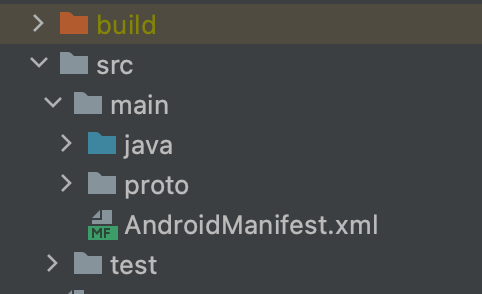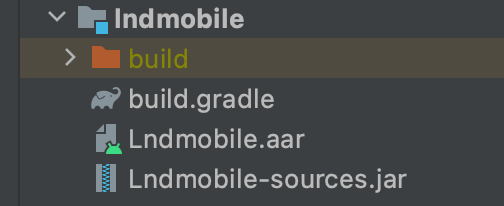* Using <details> and <summary> tags in the INSTALL.md to collapse the various platforms for installing, making the rendered page shorter and easier to read. * Simplyfying the instructions for creating LND mobile * Fixed bug in checkout of latest tagged release * Fixed bug in command for moving proto definitions to same folder as xcframework file * Use Go 1.17.6 for building the Swift proto definitions * Added link to LND Builder’s Guide |
||
|---|---|---|
| .. | ||
| docs | ||
| bindings.go | ||
| gen_bindings.sh | ||
| README.md | ||
| sample_lnd.conf | ||
Building mobile libraries
Prerequisites
To build for iOS, you need to run macOS with either Command Line Tools or Xcode installed.
To build for Android, you need either Android Studio or Command Line Tools installed, which in turn must be used to install Android NDK.
Go and Go mobile
First, follow the instructions to install Go.
Then, install Go mobile and initialize it:
⛰ go install golang.org/x/mobile/cmd/gomobile@latest
⛰ go mod download golang.org/x/mobile
⛰ gomobile init
Docker
Install and run Docker.
Make
Check that make is available by running the following command without errors:
⛰ make --version
Building the libraries
Note that gomobile only supports building projects from $GOPATH at this
point. However, with the introduction of Go modules, the source code files are
no longer installed there by default.
To be able to do so, we must turn off module and using the now deprecated
go get command before turning modules back on again.
⛰ go env -w GO111MODULE="off"
⛰ go get github.com/lightningnetwork/lnd
⛰ go get golang.org/x/mobile/bind
⛰ go env -w GO111MODULE="on"
Finally, let’s change directory to the newly created lnd folder inside $GOPATH:
⛰ cd $GOPATH/src/github.com/lightningnetwork/lnd
It is not recommended building from the master branch for mainnet. To checkout the latest tagged release of lnd, run
⛰ git checkout $(git describe --match "v[0-9]*" --abbrev=0)
iOS
⛰ make ios
The Xcode framework file will be found in mobile/build/ios/Lndmobile.xcframework.
Android
⛰ make android
The AAR library file will be found in mobile/build/android/Lndmobile.aar.
Tip: make mobile will build both iOS and Android libraries.
Generating proto definitions
In order to call the methods in the generated library, the serialized proto for the given RPC call must be provided. Similarly, the response will be a serialized proto.
iOS
In order to generate protobuf definitions for iOS, add --swift_out=. to the
first protoc invocation found in gen_protos.sh .
Then, some changes to Dockerfile need to be done in order to use the Swift protobuf plugin with protoc:
- Replace the base image with
FROM swift:focalso that Swift can be used. clang-format='1:7.0*'is unavailable in Ubuntu Focal. Change that toclang-format='1:10.0*.- On the next line, install Go and set the environment variables by adding the following commands:
RUN apt-get install -y wget \
&& wget -c https://golang.org/dl/go1.17.6.linux-amd64.tar.gz -O - \
| tar -xz -C /usr/local
ENV GOPATH=/go
ENV PATH=$PATH:/usr/local/go/bin:/go/bin
- At the end of the file, just above
CMD, add the followingRUNcommand. This will download and compile the latest tagged release of Swift protobuf.
RUN git clone https://github.com/apple/swift-protobuf.git \
&& cd swift-protobuf \
&& git checkout $(git describe --tags --abbrev=0) \
&& swift build -c release \
&& mv .build/release/protoc-gen-swift /bin
Finally, run make rpc.
Tip: The generated Swift files will be found in various folders. If you’d like to move them to the same folder as the framework file, run
⛰ `find . -name "*.swift" -print0 | xargs -0 -I {} mv {} mobile/build/ios`
Lndmobile.xcframework and all Swift files should now be added to your Xcode
project. You will also need to add Swift Protobuf
to your project to support the generated code.
Android
First option:
In order to generate protobuf definitions for Android, add --java_out=.
to the first protoc invocation found in
gen_protos.sh . Then, run make rpc.
Second option (preferable):
- You have to install the profobuf plugin to your Android application. Please, follow this link https://github.com/google/protobuf-gradle-plugin.
- Add this line to your
app build.gradlefile.
classpath "com.google.protobuf:protobuf-gradle-plugin:0.8.17"
- Create a
protofolder under themainfolder.
-
Add
aarfile to libs folder. -
After that add these lines to your
module'sbuild.gradlefile:
plugins {
id "com.google.protobuf"
}
android {
sourceSets {
main {
proto {
}
}
}
}
dependencies {
implementation fileTree(dir: "libs", include: ["*.jar"])
implementation "com.google.protobuf:protobuf-javalite:${rootProject.ext.javalite_version}"
}
protobuf {
protoc {
artifact = "com.google.protobuf:protoc:${rootProject.ext.protoc_version}"
}
generateProtoTasks {
all().each { task ->
task.builtins {
java {
option "lite"
}
}
}
}
}
- Then, copy all the proto files from
lnd/lnrpcto yourprotofolder, saving the structure. - Build the project and wait until you see the generated Java proto files in the
buildfolder.
Note:
If Android Studio tells you that the aar file cannot be included into the app-bundle, this is a workaround:
- Create a separate gradle module
- Remove everything from there and leave only
aarandbuild.gradle.
- Gradle file should countain only these lines:
configurations.maybeCreate("default")
artifacts.add("default", file('Lndmobile.aar'))
- In
dependenciesadd this line instead of depending onlibsfolder:
implementation project(":lndmobile", { "default" })
Options
Similar to lnd, subservers can be conditionally compiled with the build by setting the tags argument:
⛰ make ios
To support subservers that have APIs with name conflicts, pass the "prefix" flag. This will add the subserver name as a prefix to each method name:
⛰ make ios prefix=1

